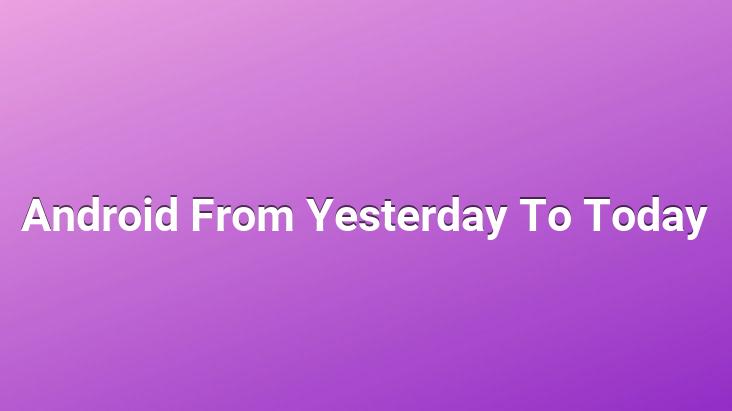
Android operating system is an operating system that was launched in 2008 as a competitor to the first iPhone released in 2007.. Of course, the journey of the operating system and even the android is based on the past.
The digital cameras developed by Andy Rubin in 2003 were named ‘Android’. Andy Rubin, who later saw the light on mobile devices, started to develop Android in this direction.. Android, which was bought by Google in 2005 just 2 years later, was the biggest harbinger of Google’s entry into the mobile industry.. Google entered the mobile market first as a software developer, not a phone maker.. It came with the HTC Dream, the first version of Android 1.0 in 2008.. Let’s take a look at how android has evolved over the years.
Android 1.0 (2008)
- It is the first Android version.
- Since it does not support virtual keyboard, it can be used by a button phone like HTC Dream.
Android 1.5 – Cupcake (2009)
- Android started naming its versions as confectionery with its first major update.
- Added keyboard for you.
- Added video recording feature that didn’t exist before.
- Added widget creation support for app developers.
< Android 1.6 Donut (2009)
- With Donut, it has become a more user-friendly operating system.
- By providing support for different screen sizes, phone manufacturers can change the screen size.
- Android m Arket has started to offer more applications and its design has been renewed.
Android 2.0 Eclair (2009)
- Google Maps with this update Navigation was added, thus functioning as in-vehicle GPS equipment.
- With HTML5 support, it gained the ability to play videos on the internet.
- The lock screen can be opened with the scrolling feature.. (Like Iphone) And the ability to mute the phone on the lock screen has been introduced.
Android 2.2 Froyo (2010)
- Froyo update received the first Nexus phone, the Nexus One.
- Switched to 5 display panels instead of 3 display panels.
- The Gallery was redesigned.
- Hotspot feature started to be supported.
Android 2.3 Gingerbread (2010)
- Redesigned home screen and default widgets.
- Multi-touch Added support.
- Introduced front camera support.
Android 3.0 Honeycomb (2011)
- First Used once on Motorola Xoom tablet.
- Makes widget skins previewable before rendering.
- Removed dependency on physical keys. Virtually added home, back and menu button.
Android 4.0 Ice Cream Sandwich (2011)
- Added facial recognition .
- Added data usage analysis.
- Mail and calendar apps are included in this update.
Android 4.1 Jelly Bean (2012)
- Added Google Now feature that offers you your events, emails and other important features with a single swipe.
- Graphics optimized. Improved touch performances.
- Fonts refreshed.
- Added expandable notifications.
Android 4.4 KitKat (2013)
- Android 4.4 KitKat appeared with Nexus 5.
- When you say “OK, Google”, Google Now feature is activated.
- Applications full screen
- Hangouts application came with the operating system.
Android 5.0 Lollipop (2014)
- First step in material design.
- Starts to work with Android Runtime instead of Dalvik VM.
- Notifications are now visible on lock screen.
- RAW image support added.
Android 6.0 Marshmallow (2015)
- Application menu updated. Added search feature for easy finding.
- Introduced memory manager. It can be seen which application used how much memory.
- Sound controls have been improved. Device sound is separated into Media sound and Alarm sound.
- Fingerprint supported for the first time.
- Added Runtime Permission feature. In other words, we are now able to allow the permissions that we accepted as ‘compulsory’, which were offered to you when downloading the application, only if it is needed.. This was a different version of Google’s saying that the strings should always be in the hands of the device owner.
Android 7.0 Nougat (2016)
- Google Now has been replaced by Google Assistant.
- Notifications can be grouped with the notification channel feature.
- Multi-window view support has been added. It’s a great feature to be able to use two apps at the same time.
Android 8.0 Oreo (2017)
- Multi-window action feature brought. The operating system has become able to continue browsing while watching videos.
- Added features such as turning off notification channels. Added features such as sorting notification by pause importance.
- Emojis have moved to a more modern look.
Android 9.0 Pie (2018)
- A single-button virtual key has been replaced instead of 3-button virtual control keys.
- Restrictions have been placed on background applications.
- Added links that enable many features to be used without opening the application.
Android 10.0 Q (2019)
- The sweet name that comes with Android 1.5 is not available in this version.
- Back key removed. One-click operation feature improved. But it’s worth remembering, you can use the old key system if you want.
- Dark mode for the system.
- Foldable phone support has been added.
- Permissions have become more controllable.
- Time information has been added in the Recent apps section.
- Feature restriction has been added to the phone given to children with parent mode.
- Do not disturb mode has been improved.
In this article, we have included the development of android from yesterday to today. Please do not forget to comment for your questions, comments and suggestions.